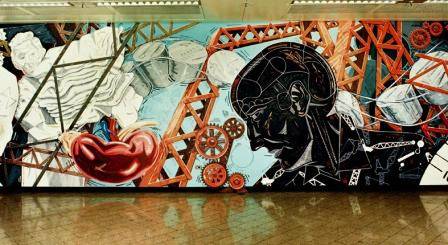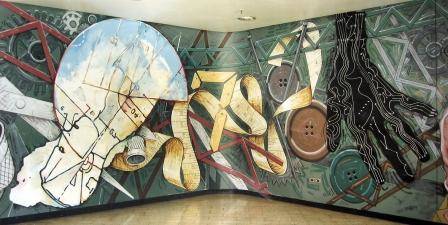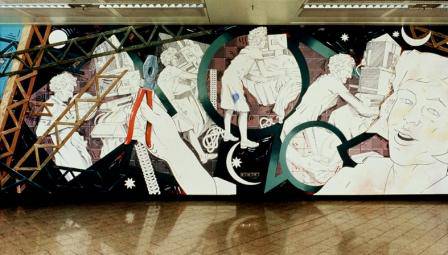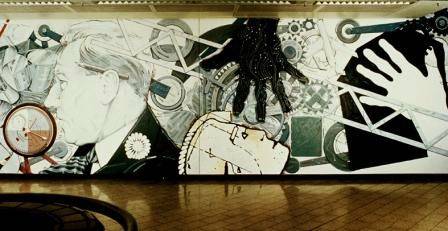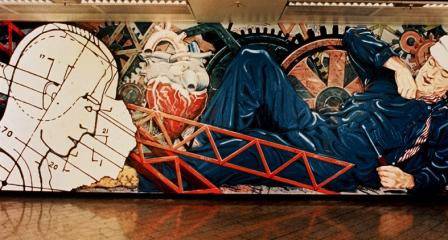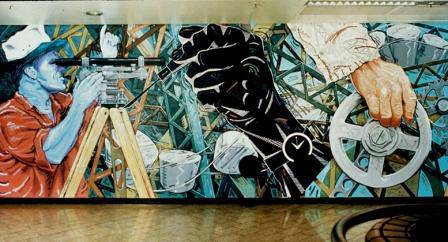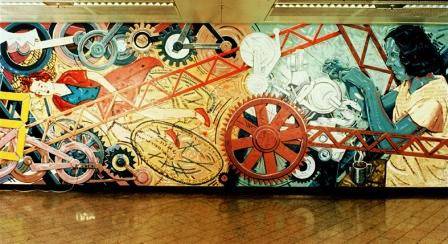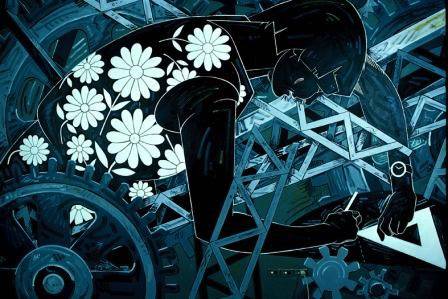| Back to search results » | Back to search page » |
|
Geoff Hogg - Museum Station Mural
Other NameMelbourne Central Station LocationMelbourne Central Railway Station, Lonsdale Street (concourse),, MELBOURNE VIC 3000 - Property No B6821
File NumberB6821LevelState |
|
Statement of Significance
What is significant? The Melbourne Central Station Mural is a large public mural spanning two walls of the Elizabeth Street concourse at Melbourne Central Station. It is visible from all areas of the concourse and from the far side of the ticket barriers, making it accessible to both train passengers and passing foot passengers outside the station as well as station employees. The mural's location - a space that is regularly passed through by city commuters - prompted the choice of theme, namely: the role of labour in the construction of society. Conceived in 1983 and completed in 1984, the mural was produced by a small team of artists from the Victorian Trades Hall Council Arts Workshop, headed by Dr Geoff Hogg (b. 1950) with assistance from Ilma Jasper (b. 1953) and sculptor Kay Douglas (b. 1952). It is painted over an expanse of wall measuring approximately 61.0 metres in length and 3.7 metres in height, or 225.7 square metres. The mural depicts a complex tableau of male and female workers from a range of occupations - trades and professions, paid and domestic - including engineers, biomedical researchers, electricians, machinists, hotel cleaners and textile workers. Interwoven among these figures are circular cogs and wheels and diagonal girders used as unifying elements. The mural was painted in situ directly onto the station concourse wall. The otherwise flat surface of the wall was broken up for aesthetic reasons through the introduction of areas of impasto surfaces and wooden relief sections made by Kay Douglas. How is it significant? Melbourne Central Station Mural is significant at a State level for historic, aesthetic and cultural reasons and on account of its representing a specific moment in Victorian social and labour history. Why is it significant? The Melbourne Central Station Mural is historically significant by virtue of its being one of the largest and most publically prominent murals ever produced in Victoria. No history of mural painting in Victoria would be complete without discussion of this landmark work. Its execution also led directly to the establishment of the Victorian Trades Hall Council Arts Workshop in 1984 (see below, under 'Contextual History'), which in turn marks a significant moment in the history of Australian trade unionism when artists and union officials sought to work productively together. The mural is also of aesthetic significance in terms of the development of community arts murals in Victoria. Unlike some other community arts schemes of the period, the Melbourne Central Station Mural is notable for the extensive planning in terms of content and aesthetics that went into its composition and the high quality of its technical execution. As the chief artist, Geoff Hogg, later recognised, this fact distinguished the mural from those being executed during the same period in Sydney where community involvement was generally emphasised at the expense of aesthetic integrity (see below, under 'Contextual History'). Culturally the mural is important because it marks a high point of the community arts movement that flourished in Australia during the late-1970s and 1980s. This movement marks a pronounced shift away from solitary artistic endeavour supported by private patronage through galleries and dealers, towards collaborative group production supported by government and/or organisational patronage such as the Arts Council of Australia. Community arts projects arose in conjunction with grass-roots community activism and are of cultural importance in terms of the changing relationship between artists and society; these projects were consciously conceived as a means of bridging a perceived gap between artists and their public, working towards a common goal such as social, political or economic reform. Specifically, the Melbourne Central Station Mural sought to celebrate workers of all kinds, highlighting the importance of their labour to the functioning and progress of Australian society. The mural also pictorially captures a particular historical moment in Victorian social and labour history. Women are represented in the mural in both professional and unskilled roles, reflecting significant changes in the labour force since the Second World War. The advent of computer technology is depicted by means of a hand wired with electrical circuits (representing biotechnology), but the majority of technical features remain mechanical and manual, reflecting the state of industry in Victoria at the time. Construction and heavy industry dominate service industries - a relationship that would be inverted in subsequent decades.
Group
Public Art
Category
Mural


